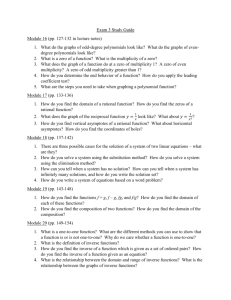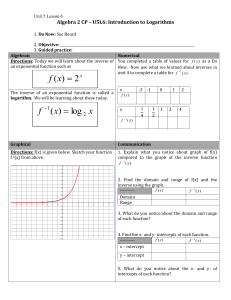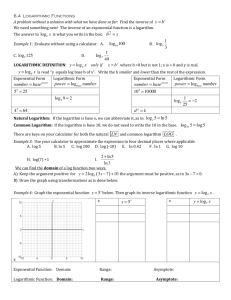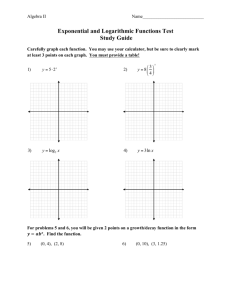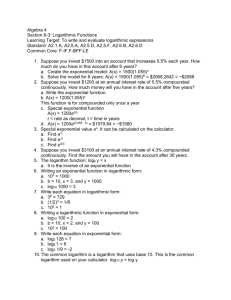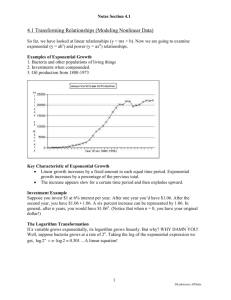Notes 5
advertisement
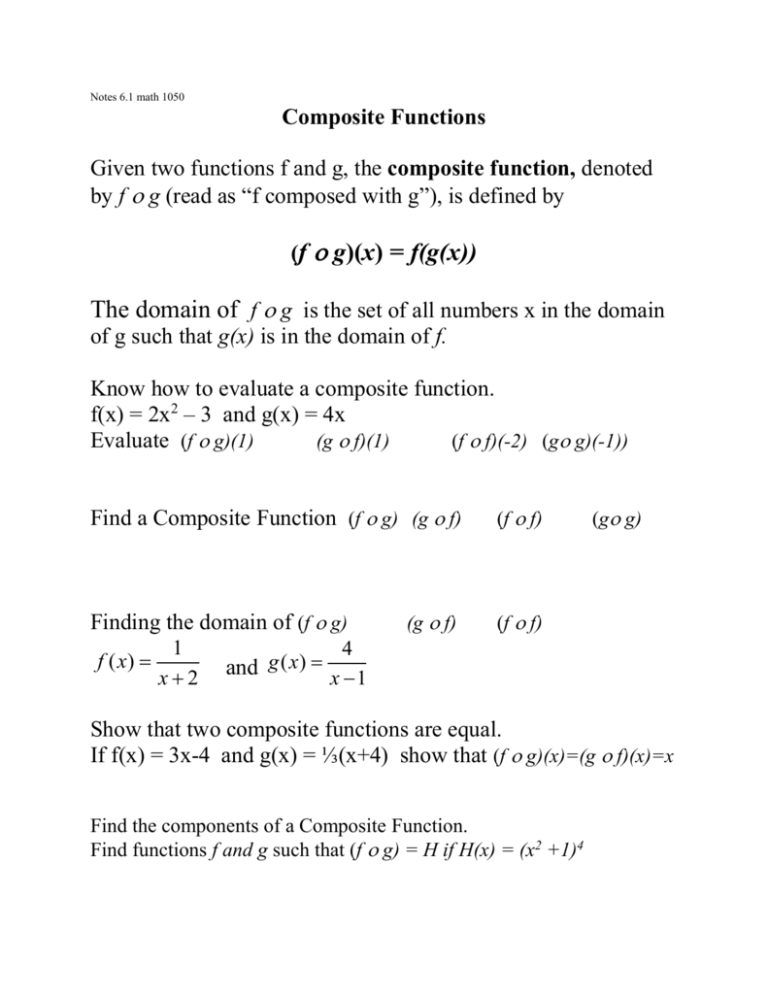
Notes 6.1 math 1050 Composite Functions Given two functions f and g, the composite function, denoted by f g (read as “f composed with g”), is defined by (f g)(x) = f(g(x)) The domain of f g is the set of all numbers x in the domain of g such that g(x) is in the domain of f. Know how to evaluate a composite function. f(x) = 2x2 – 3 and g(x) = 4x Evaluate (f g)(1) (g f)(1) (f f)(-2) (g g)(-1)) Find a Composite Function (f g) (g f) (f f) Finding the domain of (f g) (f f) f ( x) 1 x2 (g f) (g g) 4 g ( x ) and x 1 Show that two composite functions are equal. If f(x) = 3x-4 and g(x) = ⅓(x+4) show that (f g)(x)=(g f)(x)=x Find the components of a Composite Function. Find functions f and g such that (f g) = H if H(x) = (x2 +1)4 Notes 6.2 math 1050 One-to-One Functions and Inverse Functions The inverse of f If the function f is a set of ordered pairs (x,y) then the inverse of f is the set of ordered pairs (____) Horizontal-line test -- if every horizontal line intersects the graph of a function f in at most one point, then f is one-to-one. Inverse function of f is denoted as _______ Domain of f = range of f -1 Range of f = domain of f -1 f -1 (f(x) = x and f(f -1(x)) = x The graph of a function f and the graph of its inverse f -1are symmetric with respect to the line y = x To find the inverse of a function 1. 2. 3. 4. Find the inverse of f(x) = _4_ and check your answer. Graph f, f-1, 2 – x and y=x on the same coordinate axes. Guided Practice: 6.2 #49 f(x) = 3x Review: Find the domain of / x + 2 Notes 6.3 math 1050 Exponential Functions Law of Exponents If s, t, a and b are real numbers with a>0 and b>0 then asat = a s+t s t (a ) = a st 0 -s a =1 a = s s a at (ab)s = a s bs = a s-t a = b as bs 1 as 1s = 1 An exponential function is a function of the form f(x) =ax where a is a positive real number (a > 0) and a 1. The domain of f is the set of all real numbers. For an exponential function f(x) = ax, a>0, a 1 if x is any real f ( x 1) number then f ( x) a (You will use this formula to find if a function is exponential.) Also if you are given ordered pairs: find f(x) = kapx Find f(0) = kapx = ka0 = k Notes 6.3 math 1050 page 2 Properties of the Exponential Function f(x) = ax a>1 1. The domain is the set of all real numbers; the range is the set of positive real numbers. 2. There are no x-intercepts; the y-int. = 1 3. The x-axis (y=0) is a horizontal asymptote as x- 4. f(x) = ax a>1 is an increasing function and is one-to-one. 5. The graph of f contains the point (0,1); (1, a); and (-1, 1/a) 6. The graph of f is smooth and continuous with no corners or gaps. Properties of graph of an exponential function f(x) = ax 0<a<1 1. The domain is the set of all real numbers; the range is the set of positive real numbers. 2. There are no x-intercepts; the y-int. = 1 3. The x-axis (y=0) is a horizontal asymptote as x 4. f(x) = ax 0<a<1 is a decreasing function and is one-to-one. 5. The graph of f contains the point (0,1); (1, a); and (-1, 1/a) 6. The graph of f is smooth and continuous with no corners or gaps. The base e is defined as the number that the expression n 1 1 approaches as n. In calculus this is expressed n using limit notations as e = 1 lim 1 n n n e 2.718281828 Exponential equations if au = av then u = v Notes 6.4 math 1050 Logarithmic Functions y= logax (read as “y is the logarithm to the base a of x”) y= logax if and only if x = ay The domain of the logarithm function is x>0 Domain of a logarithm function = range of the exponential function = ((), ) and the range of a logarithm function = domain of exponential function (- , ) y= logax or x = ay log base number = exponent to change log to expression 5= loga4 or 4 = a5 to change expression to log 64 = 43 or 3= log464 Domain 0 < x < Range - < y < Notes 6.4 math 1050 page 2 Properties 1. Domain is the set of positive real numbers; the range is the set of all real numbers 2. x-int. = 1 There is no y-int. 3. y-axis (x=0) is a vertical asymptote of the graph 4. A logarithm function is decreasing if 0 < x < 1 and increasing if a>1 5. The graph of f contains the points (1,0), (a,1) and (1/a , -1) 6. Graph is smooth and continuous Graph of logax a>1 Graph of ax 0<a<1 If the base of a logarithm function is the number e then we have the natural logarithm function (ln) Y = logex = ln(x) if and only if x = ey Common logarithm function – when the base of a logarithm is the number 10. y = log(x) if and only if x = 10 y notes 6.5 math 1050 Properties of Logarithms Given M, N, and a are positive, real numbers; r is a real number; and a 1 log a 1 = 0 log a ar = r More Properties: log a a = 1 a log a M = M log a (MN) = log a M + log a N log M a( N ) = log a M - log a N log a (Mr) = r log a M if M = N then log a M = log a N if log a M = log a N then M = N change of base formula: if a 1 ; b 1 and a,b, and M are positive real numbers log b M log a M log b a ln M log a M ln a log M log a M log a Notes 6.6 math 1050 Logarithmic and Exponential Equations To solve logarithmic and equations, whenever possible, find the exact solutions using algebraic methods. When that cannot be used approximate the solutions by using a graphing calculator. Solve: 2log5 x log5 9 Solve log 4 ( x 3) log 4 (2 x) 1 Solve: 4 2 12 0 x x 2 5 x Solve Notes 5.6 math 1050 page 2 Solve Solve log3 x log 4 x 4 x ex 2 Notes 6.7 math 1050 Compound Interest Simple Interest Formula I = Prt I is interest, P is principal ($), t is time in years, r is rate (percent but change it to a decimal or fraction) Payment periods: annually (once per year) Semiannually (twice per year) Quarterly (4 times per year) Daily (365 times per year) Monthly (12 times per year) Compound interest – interest paid on principal and previously earned interest. Compound interest formula r nt A P (1 ) n Continuous Compounding A Pe rt The effective rate of interest is the equivalent annual simple rate of interest that would yield the same amount as compounding after 1 year. Present Value Formulas: Present value p of A dollars to be received after t years, assuming a per annum interest rate r compounded n times per year, is r P A(1 ) nt n If the interest is compounded continuously then P Ae rt Notes 6.8 math 1050 Exponential Growth and Decay; Newton’s Law; Logistic Models This is the exponential law or the law of uninhibited growth (k > 0) or decay (k < 0) where A0 A(0) is the original amount (t=0) and k0 is a constant. A(t ) A0e kt Half – life of carbon 14 is 5600 years. Newton’s Law of Cooling u (t ) T (u0 T )e kt where k < 0


